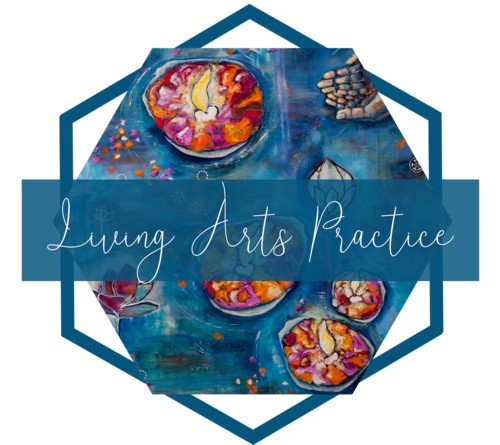Sketching Homework
Next week, we will begin to put imagery on our canvas. Ideally, this imagery has already begun to come to you through the visualization practice, but if it hasn't fully arrived, not to worry. Continue to sit with it over the next week.
Sometimes painters can feel pressure to come up with the 'right' image, or find themselves censoring or denying the imagery that shows up in their meditation. Keep in mind that this is simply a base or starting point. It will evolve and take on a life of its own that may not yet be in your mind's eye. Trust is all that is required right now.
Sketching Like a Pro...
The difference between people who sketch like a pro and people who don't is almost entirely practice. If you think that you have limited drawing ability, begin this practice by gently choosing to withhold judgement for a few minutes. Some of us had few opportunities to practice drawing, or someone once declared that our drawings weren't any good. These experiences live in the past; they no longer have to hold true for us as conscious and creative beings today. Through practice, opportunity and belief in ourselves, we are about to prove that we can learn to draw too.
For those of you who might be visualizing a person or a being of some sort in your painting, I have recorded a short video to walk you through the process of drawing a face. Do not be intimidated! The process is shared step by step, making it really quite simple. Perhaps you would even like to use your own face for inspiration. (Studying our own face can be a powerful exercise.) Take a photo of your face in the position that best emotes what you are trying to convey, and use it as a reference as you make your sketch. I once did a sketch of myself overlaid with a sketch of Frida Khalo —so fun!
Once you have your initial sketch, or a page filled with symbols, imagery and words from your meditation, you can begin to consider composition and draw a second draft of your vision.
Composition refers to the way you choose to put your visual story onto your canvas. First, consider the orientation of your image. Does it make sense to paint using a landscape (horizontal) or portrait (vertical) orientation? Shift your paper accordingly. If there is a central image, decide how much space it needs and where it will go. Don't worry if it feels like your central image is taking up most of the space. Big can be powerful. And there is always enough room to create small vignettes or visual landscapes around your central image.
Next, begin to play by adding any other images or symbols that may have shown up. If you aren't yet sure how to draw these symbols, you can simply acknowledge them in your sketch by marking a light placeholder in relation to the central image. I thoroughly enjoy this part of the process. With eraser and pencil in hand, I often change my composition several times on paper before it really feels alive. When something wants to shift in some way, be it a small or larger detail, it re-informs the rest of the composition and everything else seems to want to shift accordingly. Remember that sketching can be easeful and joyful, if you allow yourself to sketch from an easeful and joyful space within. And if it doesn't feel easeful... no problem.... this is good too. You might then practice noticing your old stories and judgements as they arise, and give your inner artist a little hug each time.
If you are sketching something for the first time and don't really know what it looks like, do what other artists do: make a study of it. Google images can provide you with a reference photo of nearly anything: a wolf, mountains, flowers, buildings. Sketching is really a practice of noticing detail, noticing how parts relate to one another, in terms of size, texture, and colour. Once you've made a study, you can add it to your composition. No need to fret about getting all the information at once. We rarely do, and even when we do, spirit often changes or transforms these images as they are being painted. Don't overthink or over complicate it. Leave some empty space to fill with inspiration as it arises!
Remember, this is intuitive, spiritual art, so your images do not need to make sense to anyone but you. They don't need to be realistic or regular. And they certainly don't need to be grounded in third dimensional reality.... blue people are most welcome. :)
Let your imagination go wild and see what your heart wants to show you!
Yoga Suggestions
Savasana
Promotes union with ourselves, stillness, peace & vulnerability
Helps relieve stress and mild depression
Reduces headache, fatigue, and insomnia
Helps to lower blood pressure
Chin Mudra
Connects us to our higher Self
Lifts dull energy
Creates a more receptive state
Calms the mind
Brightens the overall mood
Butterfly Pose
Connects us to our emotional needs, relationships and pleasure
Promotes stillness, presence and increased awareness
Opens body and heart for more easeful 'birthing' of the new
(click here for full instructions)




